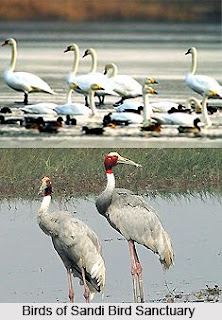The Biodiversity at Sandi Bird Sanctuary, Hardoi with Special Reference to Migratory Birds
Ashok Kumar and Meena Srivastava
Indian subcontinent plays host to a number of migratory birds in summers as well as winters. It is estimated that over hundred species of migratory birds fly to India, either in search of feeding grounds or to escape the severe winter of their native habitat. Sandi bird sanctuary was created in 1990 in order to protect and conserve the natural habitation and surroundings and also the marine vegetation for the migratory birds, as well as for the local people of the region. The term migration is used to describe movements of populations of birds or other animals. There are three types of migrants. One way to look at migration is to consider the distances traveled. The pattern of migration can vary within each category, but is most variable in short and medium distance migrants. The origin of migration is related to the distance traveled. The birds migrating through the area, take shelter on the river front before going to the Sandi Bird sanctuary.
The birds generally migrate in the winter months of October-November-December. Bird sanctuary is a popular tourist location. Sandi particularly attracts ornithologists and bird watchers, as many rare migratory birds take refuge in the sanctuary. The bird watching camps arranged to observe the migratory birds at Sandi Bird Sanctuary in the month of October and November 2012. The migratory birds at Sandi Bird Sanctuary include great crested grebe, white storks, black lbis, glossy lbis, spoonbill, ruddy shelduck, pin tail, sholveller, spot bill duck, mallard, gadwall, wigeon, tufted pochard, gargancey teal, common teal, cotton teal, grey lag goose, coot, black tailed godwit, painted stock pin tail snipe, marsh sand piper, common tern, river tern, magpie robin, white wagtail, pied wagtail, common snipe, starlings, white lbis, red crested pochard, common pochard, painted stock, black lbis, curlew, Indian skimmer etc. The residentbirds at Sandi Bird Sanctuary include little grebe, darter, purple heron, grey heron, pond heron, night heron, large, medium and little egrets, painted stork, open billed stork, cattle egret, black necked stork(endangered), combduck, lesser whistling teal, common pariah kite, brahminy kite, shikra, sparrow, hawk, tawny eagle, greater spotted eagle, crested hawk eagle, lagger falcon rain quail, jungle bush quail, painted bush quail, black partridge, grey partridge, common peafowl, water hens, purple moor hens, jacanas, black winged stilt, lap wing, blue rock pigeon, dove spp., parakeets, crow pheasants, owl, swifts, kingfishers, blue jay, hoopoe, mynas, crow, drongo, bulbul, babblers, cormorants, sarus cranes, etc. There are 38195 local birds and 11378 migratory birds (total 49572) observed during period of study. The migratory birds represent the economic importance of that particular area and faunal biodiversity along with health of ecosystem.#bharat_archives #india #mohitness #freelance_talents #hardoi #sandi


No comments:
Post a Comment